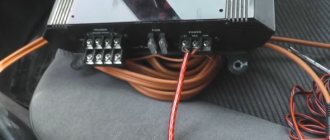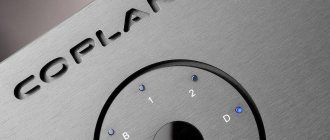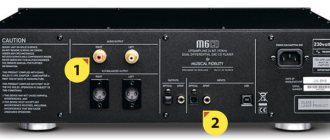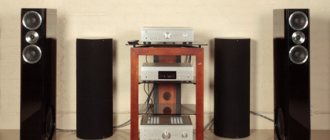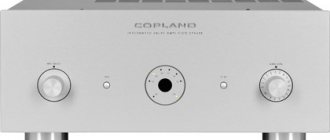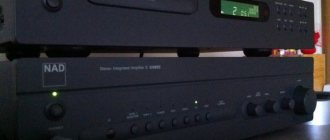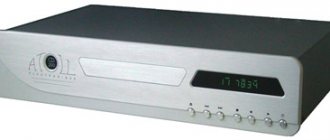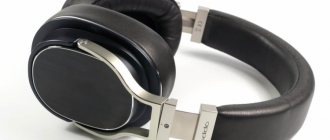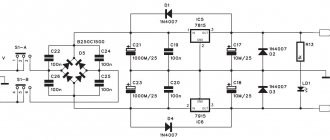Stylish design, balanced outputs, solid construction, excellent sound in the right environment.
Inconvenient controls.
NETWORK PLAYER
It is quite difficult to evaluate such an innovative device based on price, since there is practically nothing to compare it with. It would be incorrect to directly compare it with models that have a built-in hard drive, as well as with CD players of similar sound level. Nevertheless, if you imagine in which system it can provide the highest possible playback quality and take into account the presence of balanced outputs, as well as strict minimalism in design, then it is not a sin to rank it among the pantheon of Hi-End class equipment. Here, such a price tag looks relatively modest and cannot become an obstacle to the desire of the owner of a prestigious music set to connect to the home network using the most advanced device. There are absolutely no complaints about the sound and design, the creators just need to tweak the ergonomics a little, and everything will be just fine.
Design Features
Network players are a genre in the audio industry that is still new and still far from standardization and common denominators. Therefore, each manufacturer chooses its own approach to essentially one task - reproducing data stored on a computer. Some rely on external DACs operating via a USB port, others create their own protocols and produce a full range of equipment. Yamaha has currently decided to support the DLNA standard, which is used in many systems for broadcasting multimedia data to the network. The peculiarity of this protocol is that the server plays files directly, and the link transmitting to the analog circuit receives a standard stream and does not depend on compatibility with any codecs. Thus, the player is protected from rapid obsolescence when new recording formats appear. In addition, the absence of moving parts helps eliminate extraneous noise that is inevitable when playing from a hard drive or CD.
At the intersection of technologies
Being essentially a DLNA client, the Yamaha NP-S2000 requires the presence of appropriate servers on the network from which it will receive music material for playback. Such a server, for example, can be organized on your workstation by installing the popular Twonky Media software package, a license for which is included with the player. You can also resort to any other similar software that supports the DLNA standard. If you have a specialized NAS storage function on your local network, then it makes sense to activate the DLNA server there, since this application is very often included in the system software of such devices. The only important point is that when choosing a particular DLNA server, including one built into a NAS, you need to pay special attention to the compliance of the list of formats it supports with the Yamaha NP-S2000 specifications. For example, if the DLNA server is not familiar with FLAC media files, the system will not be able to play them, even though the Yamaha NP-S2000 can handle them. The issue of playback control deserves special attention. The simplest, but not the most convenient option is to select songs on the information display of the Yamaha NP-S2000 using the remote control or the joystick on the front panel of the case. However, in this case, the limited display size forces you to process multimedia files one at a time. It seems much more ergonomic to use external control using special software. This can be either a proprietary Yamaha utility for the iPhone/iPod platform, which comes with the Yamaha NP-S2000, or one of the universal software players installed on any mobile device. For example, during testing we used the Plug Player utility installed on an Apple iPad. Once you try navigating through a music library on the big screen of a tablet computer integrated into a local network via a Wi-Fi interface, a person will forever become a fan of streaming audio. Here you can create playlists according to your preferences and load them into the memory of the Yamaha NP-S2000, after which the player will be guided by them during playback. It must be emphasized that, despite the name of the utility, this software is not directly involved in playing files, but only performs control functions. All processing of multimedia information is assigned to the Yamaha NP-S2000. The sound of the model was evaluated both on material from regular CDs in 16-bit / 44.1 kHz format, and when playing phonograms with a resolution of 24-bit / 96 kHz. As expected, in its performance style, Yamaha's first network player reminded us of its wonderful SACD player CD-S2000. First of all, you pay attention to the amazing detail and accuracy of the sound. In general, the upper middle of the sound range is presented very tasty by the device, which is most clearly evident in high-resolution recordings. A dense and well-articulated bass, although it does not reach tectonic depths, nevertheless becomes a reliable foundation for a stage carefully built in all three dimensions. The Yamaha NP-S2000 perfectly keeps the rhythm and conveys to the listener the drive of catchy rock compositions, and forms a large-scale multi-layered sound canvas on classical material performed by a symphony orchestra. Brilliant result!
Service functions
The controls in the database are organized according to the usual scheme, perfected over the years for CD players. Anyone who has ever used it in relation to a network media player knows that it is completely unsuitable for one. You have to carry out all manipulations directly from the broadcasting computer, which is not a problem if it is a laptop. With stationary servers, especially those located in another room, difficulties begin. Fortunately, there is a way out. Yamaha has developed a special free application for iPhone and iPod Touch that allows you to control your media network without leaving your chair, from anywhere in the house. It makes all the capabilities of the multimedia complex easily accessible. This is exactly what a real remote control for devices like the NP-S2000 should look like.
Yamaha NP S2000
Although outwardly quite ascetic, the network player NP-S2000, however, resembles a representative of the High End world more than the other participants. The device is large and heavy; We were impressed to discover (after unscrewing 42 screws to remove the cover!) that it was actually packed to the gills with stuff - two separate transformers, a large and well-equipped sound card, etc.
41,500 RUB.
One of the reasons why so many components are needed on an audio card is because of the balanced outputs, which means doubling the component base. This solution only looks unusual because all other streamers in the test have unbalanced outputs. The NP-S2000 is also equipped with optical and coaxial outputs.
But if there are plenty of outputs here, then it is difficult to say the same about the inputs: there is only one input connector - Ethernet. There are no USB, no digital ports, no wireless connectivity. There is almost no display - just one line of text. It's done very carefully, but it means that the user will have to scroll up and down anyway to see the rest of the menu items. It is possible, however, to control an iPhone/iPod Touch or control the NP-S2000 using a home computer via a local network.
Online sources are limited to radio and podcasts, which shouldn't be taken as too severe a limitation considering how much is available there. To get music, you use Twonky media server, which is somewhat standard and comes in different flavors, so it's likely that you already have it installed. A full range of sampling rates up to 96 kHz is supported. Again, there is no way to rewind the track. We really can’t understand why this isn’t the first manufacturer to miss such an important feature?
The results of group listening of the Yamaha NP-S2000 were noticeably influenced by the tonal character of its sound - a little brightened, that is, one where high frequencies are given more preference than bass. Although once you get used to it, you discover a lot of goodies in other areas, including detail, dynamics and stage. The rhythmic characteristics of the device left mixed feelings. It's no secret that a little brightness can improve cohesion a bit, but in this case the lack of robust bass seemed to counterbalance this, and our listeners found the results disappointing.
There are other side effects, such as emphasizing the background noise of the master tape in Miles Davis compositions. On the other hand, such a manner can be useful - for example, Bach’s piece for cello and piano sounded especially successful, with the correct separation of instruments. In addition to the tonal features, our listeners also commented on the lack of integrity in the sound. Instruments and vocals could clash with each other.
In fact, the Yamaha NP-S2000 seems to be at its best when performing large-scale musical pieces and delivering the pleasure of sweeping dynamic peaks and climaxes. This is most noticeable in opera, where the player perfectly works out the lines of the choir and orchestral tutti.
LAB REPORT!
From the point of view of laboratory measurements, the Yamaha NP-S2000 performed very seriously. Starting at an output level of 2.3V and displaying lower-than-expected measured distortion with our 16/44.1 test signal, it produced a frequency response worthy of any top-end digital audio source—less than 0.06dB. The channel interference measurement left little room for possible improvement, yielding -86.5 dB. The same story was repeated with dynamic range - 95.9 dB, more than we would expect from the theoretical limit of 96 dB. We noticed further improvements when we studied the player's performance with a higher resolution signal. Overall, the NP-S2000 showed the company's desire to establish itself as a serious manufacturer of audiophile products, while keeping pace with the changing media market wherever possible.
Hi-Fi Choice VERDICT
Too expensive for its capabilities
PROS: Good with powerful music; creates a large-scale sound canvas CONS: Tonal balance clearly favors high frequencies, which results in a lack of physicality
WORK QUALITY: 4 out of 5 EXECUTION AND DESIGN: 4 out of 5 FUNCTIONALITY: 3 out of 5 TOTAL: 4 out of 5
IMPARTIAL VERDICT
Adapted from HIGH DEFINITION By RICHARD BLACK, HI-FI CHOICE
Sound quality
The sound of the device largely depends on the network settings and the software player that directly creates the DLNA stream. With proper organization of the process, results can be achieved that are more than impressive. A well-recorded FLAC file sounds as good as a CD from a very high-end CD player. Not every audiophile will actually notice the substitution, but for music lovers, even the most demanding ones, this quality will be even more than enough. Precise bass control and transparent highs create an atmosphere of a completely un-Japanese sound, which traditionally suffers from some simplicity and anemia. The vocals are conveyed deeply and in detail, the feeling of the performer’s presence directly in the room is sometimes mesmerizing. Such a sum of acoustic advantages requires an expensive amplifier and speakers, otherwise the potential will remain unexploited. A balanced channel connection provides a significant, clearly audible advantage over an unbalanced channel. It makes sense to ensure that the entire audio path supports this type of connection.
59,000 rubles.
Oppo HA-1 Headphone Amplifier/DAC and Yamaha A-S1100 Integrated Amplifier
Seeing a revival of interest in stereo Hi-Fi components among the general public interested in sound, we decided to test Oppo and Yamaha components again (see previous test), but this time aimed at high-quality reproduction of stereo recordings at home. At the same time, both components have the necessary switching capabilities for integration into an existing multi-channel system. This time we tested the Oppo HA-1 headphone amplifier/DAC and the Yamaha A-S1100 integrated amplifier.
Oppo HA-1
The Oppo HA-1 is a discrete balanced Class A headphone amplifier and stereo preamp with bypass for home theater use. The device supports sampling rates up to 384 kHz and bit rates up to 32, DSD up to 256. A full list of characteristics can be found on the manufacturer’s website.
Oppo HA-1 has an all-aluminum body with a 1cm thick bezel. The massive body design (metal chassis integrated into the main cabinet body) contributes to the fight against unwanted vibrations of the device. Ventilation is provided both on the top and bottom. Oppo HA-1 has on board a linear power supply with a toroidal transformer. For the digital part, the preliminary and output amplification stages there are separate power supply and stabilization circuits. Buffer capacity - almost 40 thousand microfarads. For digital inputs, several controllers are used with their own clock generators and a 128 MB buffer memory chip. The XMOS USB controller operates in asynchronous data transfer control mode. The DAC chip is a 32-bit ESS ES9018 Saber chip. Oppo HA-1 has a balanced architecture and operates in the A-class. Looking ahead, we note that the device heats up noticeably during operation, but this does not affect the stability of operation. You just need to provide enough space for ventilation.
Consider the façade of the device. The large LCD display, large input/tuning and volume selection knobs immediately catch your eye. Also on the facade there is a USB input, a power button and headphone outputs (6.3 mm and balanced XLR 4-pin). The volume control is analog with a motorized knob. The device has two operating modes: for headphones with a resistance of less than 100 Ohms, the normal mode is intended; for headphones with a higher impedance, the high power mode is intended.
Although the Oppo HA-1 is positioned primarily as a headphone amplifier, the purpose of our testing was to find out whether this device can replace a stationary DAC and preamplifier in a Hi-Fi system. There are prerequisites for this. The range of inputs and outputs will satisfy even the most demanding user:
There are four digital inputs (optical, coaxial and AES/EBU, USB type B), a jack for the included Bluetooth antenna, analog inputs and outputs with RCA and XLR connectors. There are also trigger inputs and outputs for synchronously turning on or off multiple devices in the audio system.
You can enable the signal pass-through mode to the analog outputs without using the volume control: when a signal is received at the analog inputs, the sound is output through the analog outputs at a maximum fixed volume. Bypass mode can be assigned to any input source and can be used when integrating the Oppo HA-1 as a stereo preamp in a multi-channel system. We could not remember a mass product with such a function.
We install the Oppo HA-1 in the rack and connect it to the network.
Setting up the device is intuitive: the input selection knob here is multifunctional; you can scroll through the menu pages by rotating it, and select inputs and modes by pressing. The display can show the signal spectrum, channel indicators, or signal information. You can also turn off the display. I liked the volume control because it was smooth, there was no imbalance between channels and no audible sound distortion, and such problems sometimes occur with devices with simple or low-quality controls. The Oppo HA-1 comes with a convenient card-type remote control that fits comfortably in your hand and has direct input selection buttons. This came in handy as we listened from three different inputs: USB, analog and digital coaxial.
We make connections with the Yamaha A-S1100 amplifier using analogue (RCA).
Yamaha A-S1100
The Yamaha A-S1100 is an integrated stereo amplifier with 160 Watts (4 ohms) per channel, 250 damping factor, vintage design and an impressive 23.3 kg weight. A full list of characteristics can be found on the manufacturer's website.
Let's take a look inside. The transformer is quite large and is mounted in a separate shielded unit. Four “barrels” of capacitors with a capacity of 18,000 microfarads are installed. The design is symmetrical, the power supply is located in the middle, the power amplifiers are symmetrically on the left and right. The output links of the PA are based on field-effect transistors. The manufacturer declares “a unique technology of symmetrical power amplification with “floating” power supplies developed by Yamaha specialists.” The body is massive, rigid and stable.
The front of the amplifier is a solid aluminum plate 5 mm thick with specially applied abrasions. Traditional Yamaha toggle switches, rotary knobs and round knobs look harmonious on it. The volume control is large, the input switch has fixed positions with a clear tactile sensation of stopping. We were pleased with the presence of tone control, which is rarely found in amplifiers these days - bass and treble. There is no regulator for the midrange. There is no separate button for Direct mode, but when both tone controls are set to the middle position, a distinct click is heard and the amplifier goes into Direct mode (bypassing the tone circuit). Also on the front there is a 6.3 mm stereo output for headphones, which is also not always found in modern amplifiers.
The amplifier is equipped with two pairs of terminals for each channel and has a very conveniently implemented switching circuit between pairs of terminals: you can turn off both pairs, select the desired one, or turn on both. Since we have experience in connecting a subwoofer at a high level, the presence of such a variety of connections allows you to control the triphonic very flexibly. Looking ahead, we note that we did not need such a connection, since the Yamaha A-S1100 has a Pre-out output on board, which, again, is not often found in amplifiers of this budget class. Another use for two pairs of terminals per channel is to connect two pairs of speakers to an amplifier (for example, to work in different rooms). It makes no sense to use such switching for bi-amping, and this is a common situation for all amplifiers of a similar design, and the manufacturer does not declare such a possibility anywhere.
The rear part of the amplifier, in addition to a considerable set of inputs, attracts attention with the unusual design of the terminals (as it turned out during testing, they were easy to connect), the presence of an input for a record player (both with an MC and MM head), and a Pre-output. out and Main-in input (direct input). The signal from this input bypasses the tone and volume controls directly to the power amplifier. It is to this that we connect the analog output of the Oppo HA-1 DAC and adjust the volume on the DAC.
The façade is decorated with dial analogue playback level indicators, reminiscent of devices from the 70s and 80s of the last century. They look especially good in a darkened room when the backlight is turned on. If desired, the indication can be turned off using a switch on the facade. That's all the controls. Oh yes! The final touch to the “old school” facade design is the Mute toggle switch. This is the first time we have seen such an implementation of this function! Of course, you can turn off the sound from the remote control, which turned out to be very convenient and not burdened with unnecessary buttons. A rare case: you can enable direct input from the remote control. This is very convenient when working as part of a recreation center - for example, if you need to switch to a stereo source connected to the amplifier after watching a movie, when the amplifier received a signal from the preouts of the receiver fronts. Speaker pairs cannot be switched from the remote control. Also, you cannot adjust the tones from the remote control.
In general, the design of the facade is harmonious and pleasing to the eye. Yamaha - wooden sides of the case, which complete the image and look great with other components of the company (in our case, with the Yamaha NP-S2000 network player, which we used as transport).
Acoustics and other components of the system under test
We decided on the source, DAC and amplifier, and as for the acoustics, fortunately time allowed, various options were tested.
Among others, we tried the Dali Rubicon 2
— unique compact speakers in their own way. The Twitter module here is borrowed from the flagship Dali Epicon series. According to the manufacturer, Dali Rubicon 2 have an extremely smooth, wide dispersion, and the body (six layers of MDF, curved shape) almost completely eliminates standing waves. The midrange/woofer cone is made of lightweight paper reinforced with wood fibers, which also eliminates resonances as the fibers are unevenly spaced. The midrange/bass driver uses soft magnetic compounds, which eliminates variations in the magnetic field in the gap. The result is a good attack, light mid, airy top.
The appearance of the speakers is truly chic, and preliminary listening confirmed the manufacturer’s sound promises: it is smooth, balanced in frequencies. During testing, for greater objectivity, we additionally used floor acoustics.
The final composition of the system under test, taking into account the components with which the comparison was made:
- sources
: Yamaha NP-S2000 network player, Oppo BDT-101C disc player - DAC
: Oppo HA-1, DAC CS4398 (author's) and DAC built into Yamaha NP-S2000 - amplifiers
: Yamaha A-S1100, Musatoff PA-20 - acoustics
: Dali Rubicon 2, Sonab B32, Arslab Classic 3 and KEF Xq40
Impressions from testing
It was easy to identify the signature sound of the Oppo HA-1 DAC - festive, as detailed as possible, but not tiring. To identify the sound features of the DAC, we had to reconnect to another amplifier, since the sound of the Yamaha A-S1100 seemed to us not transparent enough for tests - the signature of this amplifier was felt even in Direct mode. (Subsequently, I managed to listen to a Yamaha amplifier two steps higher (and with a proportionally higher price), and this feature was not noted there.) What I didn’t like about the sound of the Yamaha A-S1100: sometimes there was a “mess” in difficult moments, the dynamic performance was not reached the level of the main amplifier in the system (original, but more expensive). In general, the sound, it seemed to us, has the signature of the company's top receivers, which in itself is not a verdict, since Yamaha receivers sound very good in stereo, as we had the opportunity to verify when testing the company's top receiver. But we expected better detail and greater amplitude of sound production from the amplifier. Here one could hear the general “tightness” of the sound when listening to classical music, violin compositions and the Great Symphony Orchestra. Some unnaturalness (syntheticity) was felt when listening to the piano, although trumpets and female vocals were reproduced quite naturally, not loudly. In other styles, especially rock and electronic genres, the amplifier produces a perky, one might even say cocky sound with good bass control. And part of the credit here goes to the Oppo HA-1 DAC.
As for the operation of the amplifier as part of a multi-channel system, we did not have any complaints about the convenience of switching or the thoughtfulness of switching modes. I was pleased that when turned on, the amplifier switches the last used input, including Main-in. Sound-wise, no complaints. Perhaps the overall result was influenced by the unloading of the receiver's power supply from the need to drive the front channels and the increase in the total reserve of undistorted power on all channels of a multi-channel system.
Returning to stereo, to check the quality of the Yamaha's built-in preamplifier, we reconnected from the Main-in input to the amplifier's line input and adjusted the volume on the amplifier. There was no significant loss in sound quality, which suggests that the quality of the preamplifier matches the overall quality of the amplifier and is not a weak link.
It should be noted that listening impressions are subjective and cannot be measured. In addition, the auditions were carried out by different groups of listeners, and some of them consider themselves audiophiles - they are extremely demanding of sound quality and know by heart how test tracks can sound. We assume that a typical music lover will not notice most of the noted shortcomings, since in general the sound of the amplifier is balanced, and in combination with the Oppo HA-1 it is also energetic. For more demanding music lovers and audiophiles, it makes sense to take a closer look and listen to the higher models in the company’s line, they are worth it. For example, the 3000th model is completely devoid of the sound flavor of Yamaha receivers. However, the purchase budget will be completely different.
Still, let's try to describe our impressions in words using specific tracks as examples.
Album Papa' John DeFrancesco "A Philadelphia Story" FLAC 44.1/16, track "Papa Was A Rolling Stone". The “rocking” rhythm section in all combinations of system components, the differences can be heard in the presentation of the guitar, it is in the foreground or goes a little into the background depending on the combination of components. At the same time as the guitar, barely audible vocals sound - in some combinations it is almost inaudible, and the track can be mistaken for a pure instrumental! With the Oppo HA-1, the guitar is in the foreground and the vocals are clearly audible.
Collection “The World's Greatest Audiophile Vocal Recordings” FLAC 96/24, track Fever. The recording was made with sibilants (clicking sounds on hissing ones). Oppo HA-1 does not mask them, but at the same time they do not cause discomfort, they are simply taken for granted. In other variants of combinations of devices in the test system, these sounds were either masked, which created the illusion of comfortable sound due to the blockage of the frequency response at high frequencies, or were unnecessarily prominent, causing obvious discomfort when listening. The winds are presented sharply, but not uncomfortably. Very informative, without loss of detail or blurring. In general, this track is a very good test of the nature of the RF supply in the system.
Collection "The World's Greatest Audiophile Vocal Recordings" FLAC 96/24, track "Isn't it A Pity". Vocals here should sound open and without loss of dynamic range, the sound of the piano should not have synthetic overtones. The Oppo HA-1 did an excellent job, although for many components it is the natural sound of the piano that is a stumbling block.
The general impressions from testing the combination of Oppo HA-1 and Yamaha A-S1100 are as follows: with any connection with a good source, you can count on receiving the maximum musical information in this budget with rich, detailed sound when connecting both bookshelf and floor-standing speakers of various designs. But, as we have established by connecting different amplifiers, there is a reserve for growth, and the limiting factor in this combination for our demanding musical tastes is the amplifier. This DAC is worthy of higher level amplification. Oppo HA-1 was remembered for its fullness of sound, ability to convey the scene and the slightest nuances, and excellent transmission of the bass base. We were not able to assemble a system in a month in which this particular DAC would become the weak link. Although, of course, we admit that this is possible - the whole question is in the budget, and our tests are mainly focused on a mass product. It should also be noted that we had almost no complaints about the reproduction of popular genres (rock, electronics) using the tested combination.
